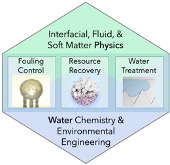2022 Annual Meeting
(2ec) Interfacial Engineering and Fluid Dynamics for Water and Sustainability
Author
My research utilizes advances in the fields of interfacial/colloidal science, fluid mechanics, and soft matter physics towards applications in water treatment, resource recovery, and sustainability. I am particularly interested in how water chemistry and lyotropic effects can profoundly influence interfacial processes and thus dictate the success or failure of engineering interventions. For example, material fouling is highly dependent on water composition (pH, presence of co- and counter-ions, ionic strength, etc.). Material science advancements have introduced a multitude of strategies for reducing fouling; however, these strategies often target specific contaminants while neglecting others. Fouling by one contaminant induces vulnerabilities to others, which creates a critical failure mechanism when multiple foulants are present. Thus, understanding solution chemistry is key for designing engineering interventions.
In one recent effort published in Science Advances, I was able to take advantage of lyotropic properties of sodium chloride (namely, the moderate slope of its temperature-solubility relationship) combined with interfacial engineering to create nanoscale superhydrophobic materials that induce ejection of crystals formed from evaporating saline drops. This work demonstrated the importance of ion-specific properties, the importance of specific micro/nano-scale textures, and how the combination of both can lead to new innovations. By completely ejecting salt from the solid interface, these materials enable new possibilities for sustainable processes such as evaporative heat exchange systems using drops of saline water or new strategies for handling and processing of waste brines.
Continued research into the applications and limits of interfacial engineering for fouling control will capitalize on my existing work by further investigating how specific components of surface energy (polar, nonpolar, positive, negative, etc.) and micro/nano-scale textures influence heterogeneous precipitation of common foulant minerals. However, modification of surface wettability alone is insufficient to address fouling across multiple mechanisms, as materials which successfully resist one form of fouling are often vulnerable to another. Hydrophobic surfaces reduce crystal-fouling, while hydrophilic surfaces reduce organic absorption; and biofilm growth has a complex relationship with surface properties. My solution to this challenge is to design and test active soft materials which resist fouling across a broad spectrum of contaminants by generating motion in situ. These materials can be designed from multiple layers of wrinkled hydrogels with disparate swelling properties in order to induce a bending moment upon activation.
Another challenge at the intersection of interfacial engineering and water chemistry is the recovery of resources from waste. Sustainable recovery of phosphate, in particular, is a critical challenge for sustaining food for growing populations and for protecting water resources from eutrophication. One solution is to crystallize phosphate minerals (struvite) from wastewater. Existing crystallizer technologies consume a significant amount of energy and/or large amounts of chemicals to increase reactor pH levels to promote precipitation. Preliminary work in my dissertation demonstrated that nano-porous particles can vastly (up to 5x) increase struvite nucleation kinetics, and that the specific length scale of nano/micro-features has a controlling factor in nucleation and growth. I propose to further improve these results by designing materials that combine enhanced nucleation with alteration of local solubility. Janus particles with one side composed of a nano-porous material and the other containing a slow-release hydroxide chemistry are one embodiment of this concept. Slow dissolution of the hydroxide chemistry will decrease the solubility of struvite in the vicinity near the particle to promote rapid precipitation on the porous face for efficient phosphate recovery while minimizing chemical consumption.
A final research thrust combines microfluidics for fine-tuned control over reaction-limiting transport phenomena (diffusion, light-penetration, and removal of reaction byproducts) with interfacial engineering for enhanced catalysis to create continuous flow photocatalytic reactors for water treatment. One major transport limitation in current photocatalytic reactors is a deficiency of dissolved oxygen. Plastron within superhydrophobic surfaces can address this by serving as in situ oxygen reservoirs. Microfluidic devices functionalized with both superhydrophobic pores and with ZnO catalyst nanowires allow for photocatalytic degradation of contaminants at the triple phase contact line where pollutants, immobilized catalyst, and dissolved oxygen are present in abundance. The goals of this work are to study and optimize how air is trapped within superhydrophobic pore and to simultaneously maximize flow rates and treatment kinetics
Teaching Interests
I am most enthusiastic about courses related to colloidal/interfacial science, transport phenomena, and water chemistry/engineering. My teaching experience is primarily in transport phenomena and thermodynamics meaning that I can teach a variety of core departmental courses. At the graduate level, I would be comfortable teaching advanced transport phenomena, colloid science, and fluid mechanics. I would also love the opportunity to share my research interests with students by developing a course on interfacial engineering applied to topics in water and sustainability.
